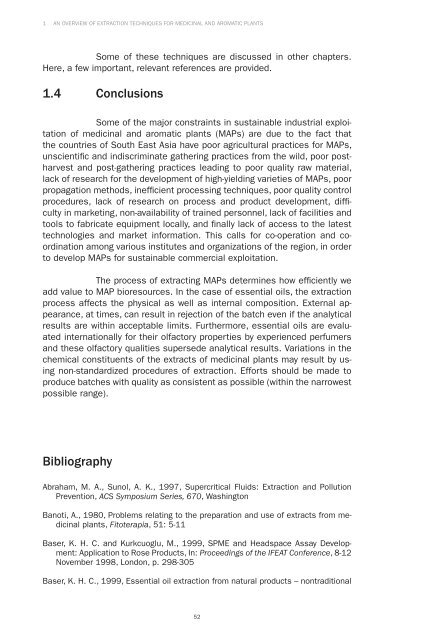Extraction Technologies for Medicinal and Aromatic ... - Capacity4Dev
Extraction Technologies for Medicinal and Aromatic ... - Capacity4Dev
Extraction Technologies for Medicinal and Aromatic ... - Capacity4Dev
You also want an ePaper? Increase the reach of your titles
YUMPU automatically turns print PDFs into web optimized ePapers that Google loves.
1 AN OVERVIEW OF EXTRACTION TECHNIQUES FOR MEDICINAL AND AROMATIC PLANTS<br />
Some of these techniques are discussed in other chapters.<br />
Here, a few important, relevant references are provided.<br />
1.4 Conclusions<br />
Some of the major constraints in sustainable industrial exploitation<br />
of medicinal <strong>and</strong> aromatic plants (MAPs) are due to the fact that<br />
the countries of South East Asia have poor agricultural practices <strong>for</strong> MAPs,<br />
unscientifi c <strong>and</strong> indiscriminate gathering practices from the wild, poor postharvest<br />
<strong>and</strong> post-gathering practices leading to poor quality raw material,<br />
lack of research <strong>for</strong> the development of high-yielding varieties of MAPs, poor<br />
propagation methods, ineffi cient processing techniques, poor quality control<br />
procedures, lack of research on process <strong>and</strong> product development, diffi -<br />
culty in marketing, non-availability of trained personnel, lack of facilities <strong>and</strong><br />
tools to fabricate equipment locally, <strong>and</strong> fi nally lack of access to the latest<br />
technologies <strong>and</strong> market in<strong>for</strong>mation. This calls <strong>for</strong> co-operation <strong>and</strong> coordination<br />
among various institutes <strong>and</strong> organizations of the region, in order<br />
to develop MAPs <strong>for</strong> sustainable commercial exploitation.<br />
The process of extracting MAPs determines how effi ciently we<br />
add value to MAP bioresources. In the case of essential oils, the extraction<br />
process affects the physical as well as internal composition. External appearance,<br />
at times, can result in rejection of the batch even if the analytical<br />
results are within acceptable limits. Furthermore, essential oils are evaluated<br />
internationally <strong>for</strong> their olfactory properties by experienced perfumers<br />
<strong>and</strong> these olfactory qualities supersede analytical results. Variations in the<br />
chemical constituents of the extracts of medicinal plants may result by using<br />
non-st<strong>and</strong>ardized procedures of extraction. Ef<strong>for</strong>ts should be made to<br />
produce batches with quality as consistent as possible (within the narrowest<br />
possible range).<br />
Bibliography<br />
Abraham, M. A., Sunol, A. K., 1997, Supercritical Fluids: <strong>Extraction</strong> <strong>and</strong> Pollution<br />
Prevention, ACS Symposium Series, 670, Washington<br />
Banoti, A., 1980, Problems relating to the preparation <strong>and</strong> use of extracts from medicinal<br />
plants, Fitoterapia, 51: 5-11<br />
Baser, K. H. C. <strong>and</strong> Kurkcuoglu, M., 1999, SPME <strong>and</strong> Headspace Assay Development:<br />
Application to Rose Products, In: Proceedings of the IFEAT Conference, 8-12<br />
November 1998, London, p. 298-305<br />
Baser, K. H. C., 1999, Essential oil extraction from natural products – nontraditional<br />
52

















